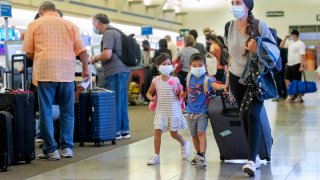
With several of the area's largest school districts in North Texas about to go on spring break, many families in Dallas and Fort Worth may be taking their first trip together since the omicron variant of coronavirus wrecked the holidays.
The Centers for Disease Control and Prevention guidelines have changed since then. Here's what you need to know.
Two weeks ago, the CDC outlined the new set of measures for communities where COVID-19 is easing its grip, with less of a focus on positive test results and more on what’s happening at hospitals.
The new system greatly changes the look of the CDC's risk map and puts more than 70% of the U.S. population in counties where the coronavirus is posing a low or medium threat to hospitals. Those are the people who can stop wearing masks, the agency said.
Get DFW local news, weather forecasts and entertainment stories to your inbox. Sign up for NBC DFW newsletters.
The changes might be a little confusing and daunting for families who are venturing onto a plane or embarking on a road trip far away from home.
Doctors from Children’s Health are offering some insight.
“This has been a fluid process as you have seen from the beginning. And we need to adjust to what we learn from the virus, what tools we have,” said Dr. Carla Garcia-Carreno, pediatric infectious disease specialist at Children's Health.
When making family decisions about whether or not to mask up, doctors said your plan should be tailored to you.
“First of all, it’s really important to reinforce that this is guidance more than a mandate and your personal preference is still really important on your decision making,” said Garcia-Carreno. “But basically, what the CDC tried to do is that at this point, we are at a different place compared to a year ago and two years ago when the pandemic started. We have more tools available now to both prevent and treat COVID-19.”
Before you travel for spring break or begin planning a trip in the coming months, think about these three major things:
CONSIDER COMMUNITY LEVELS
At home or on the road, understanding the severity of COVID-19 where you are going is crucial to family safety.
While cases are dropping across the country, denser populations or certain areas might still have risks.
“Still, the outdoor activities are going to be less risky than indoor activities,” said Garcia-Carreno. “So I think what we have learned at this point is to live with a virus and not say – be inside of a cage but try to get some sense of normalcy now that we have better tools to prevent entry.”
You can track how COVID-19 is impacting your community by checking the CDC's Community Level Map.
EVALUATE FAMILY RISK FACTORS
Families should be cautious when they have family members with weakened immune systems. What are your family risk factors? Does someone have a weakened immune system or asthma? Doctors said you should mask up still if that's the case.
"Those kids that are less than five that have not been able to be eligible to be vaccinated yet or the older persons that have not received the vaccine -- usually they are also at a higher risk to becoming infected and having more severe disease. So based on this kind of like risk scale, you can decide about your mask use,” said Garcia-Carreno.
CONTACT YOUR CHILD'S PEDIATRICIAN
What does your child’s pediatrician think? No one knows your child's health and potential risks better than their doctor. If you have any concerns or questions, you should have a conversation with them before embarking upon big family plans.
"It's really important to have a conversation with primary care providers like your child's pediatrician and your family physician because they can help you understand OK, what is the risk factor level of my family and my children specifically?" said Garcia-Carreno.
The new recommendations do not change the requirement to wear masks on public transportation and indoors in airports, train stations, and bus stations. Federal mandates about masking on public transportation were extended this week until at least April 18. The CDC guidelines for other indoor spaces aren’t binding, meaning cities and institutions even in areas of low risk may set their own rules. And the agency says people with COVID-19 symptoms or who test positive shouldn’t stop wearing masks.

